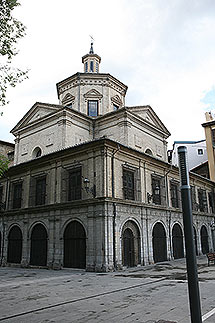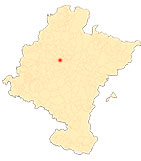The chapel of San Fermín
Introduction
The desire to erect a worthy shelter for the reliquary image of San Fermín led Pamplona City Council to become the promoter of his Chapel, annexed to the parish church of San Lorenzo, which was built between 1696 and 1717, according to plans by the tracista Santiago Raón, Fray Juan de Alegría and Martín de Zaldúa. The financing, endowed with funds from the municipality and channelled through the exercise of its board of trustees, sometimes discussed and finally ratified in 1720, also involved Pamploneses and Navarrese of various kinds, some living in Madrid, mostly members of the Royal Congregation of San Fermín de los Navarros, set up in the Court in 1684; and others, dispersed in the Indies (Spanish America and the Philippines). After its inauguration, the Baroque Chapel of San Fermín underwent certain alterations. Thus, between 1800 and 1805, those undertaken under the direction of Santos Ángel de Ochandátegui, which, in addition to the reconstruction of the dome, affected mainly ornamental aspects, both inside the enclosure and, to a lesser extent, the exterior, of agreement with the academic taste of the time, a prelude to Neoclassicism. As a result, the building corresponds to the Baroque statement of core values , especially structurally, and follows academic classicist concepts, especially evident in the interior, as far as the ornamentation is concerned. As a result of a bombardment in September 1823, on the occasion of the expedition known as the Hundred Thousand Sons of Saint Louis, the Chapel was damaged and the lantern, the crowning glory of its dome, was demolished, but it was rebuilt in February 1824.
-
ANÓNIMO, Relación de las Plausibles Fiestas con que ha celebrado la Mui Noble i Mui Leal Ciudad de Pamplona, Cabeza del Ilmo. y Fidelissimo Reyno de Navarra, la Translación de su Gran patron saint San Fermín de la Antigua Capilla a la Nueva, que ha fabricado su devoción, Pamplona, Juan José Ezquerro, 1717.
-
GARCÍA GAINZA, M. C. and others, Catalog Monumental de Navarra, t. V***, Merindad de Pamplona. Pamplona. Indices generales, Pamplona, Government of Navarra, Archbishopric of Pamplona, University of Navarra, 1997, pp. 187-196.
-
MOLINS MUGUETA, J. L., Capilla de San Fermín en la iglesia de San Lorenzo de Pamplona, Pamplona, Diputación Foral de Navarra-Institución "Príncipe de Viana",Ayuntamiento de Pamplona, 1974.
-
MOLINS MUGUETA, J. L., El culto a San Fermín, in "Sanfermines. 204 horas de historia", Pamplona, Larrión y Pimoulier, 1992, pp. 31-39.
-
MOLINS MUGUETA, J. L., Las Capillas de San Fermín y Ntra. Sra. del Camino en Pamplona, in "El Arte en Navarra", no. 27, Pamplona , Diario de Navarra, 1995 , pp. 417-432.
-
On the website of the Chair de Patrimonio y Arte Navarro: An example of a "green man" in the Chapel of San Fermín in Pamplona, in "La pieza del mes", December 2013.












